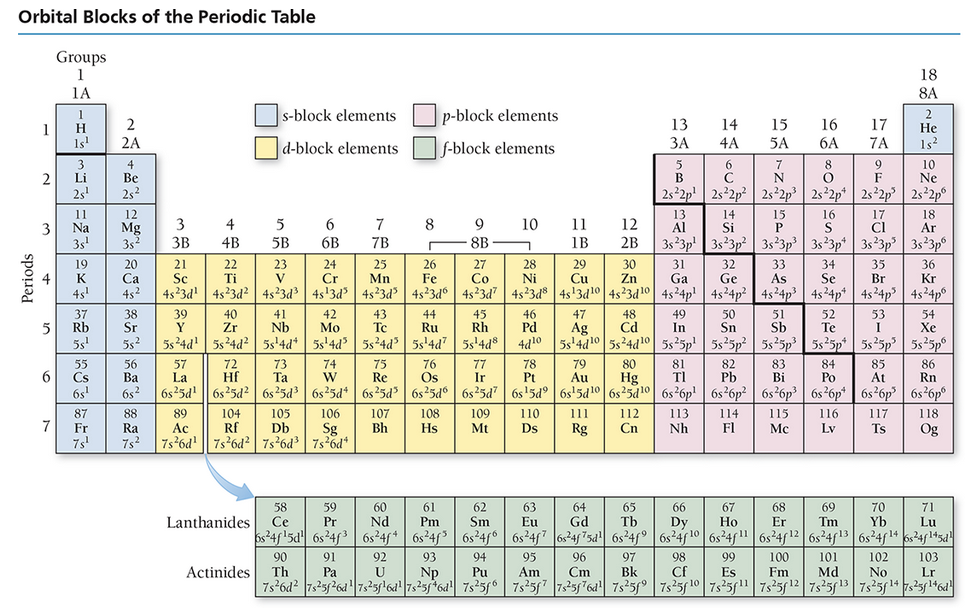
The arrangement of the periodic table can be used to determine the electron configuration of any element.
For instance, the electron configuration of hydrogen is 1s 1 .
- The “1” in 1 s 1 indicates the first energy level of the atom and directly correlates to the first row of the periodic table.
- The “ s ” in 1 s 1 indicates that hydrogen has electrons in the “ s ” orbital, which correlates to the s block of the periodic table.
- The “ 1 ” in 1 s 1 indicates that hydrogen has one electron in the “ s ” orbital.
Using the periodic table, fill in the missing component of the electron configuration for boron.
B = 1 s 2 2 s 2 2_ 1
- p
- s
- 1
- 2
- 1
- 3
p
Ex.
The electron configuration for B = 1 s 2 2 s 2 2 p 1 , so the missing piece of the electron configuration is “ p .”
Boron is the first element in the second row of the p block. This information accounts for the “2 p 1 ” portion of the electron configuration. The remaining portion of the electron configuration (1 s 2 2 s 2 ) takes into account all of the electrons prior to the 2 p orbitals.
Diamagnetic species, which are not attracted to a magnetic field, have no unpaired electrons. Paramagnetic species contain at least one unpaired electron and are attracted to a magnetic field.
Is boron, B, diamagnetic or paramagnetic? Why?
- Boron is diamagnetic because it has unpaired electrons.
- Boron is diamagnetic because all of its electrons are paired.
- Boron is paramagnetic because all of its electrons are paired.
- Boron is paramagnetic because it has unpaired electrons.

Boron is paramagnetic because it has unpaired electrons.
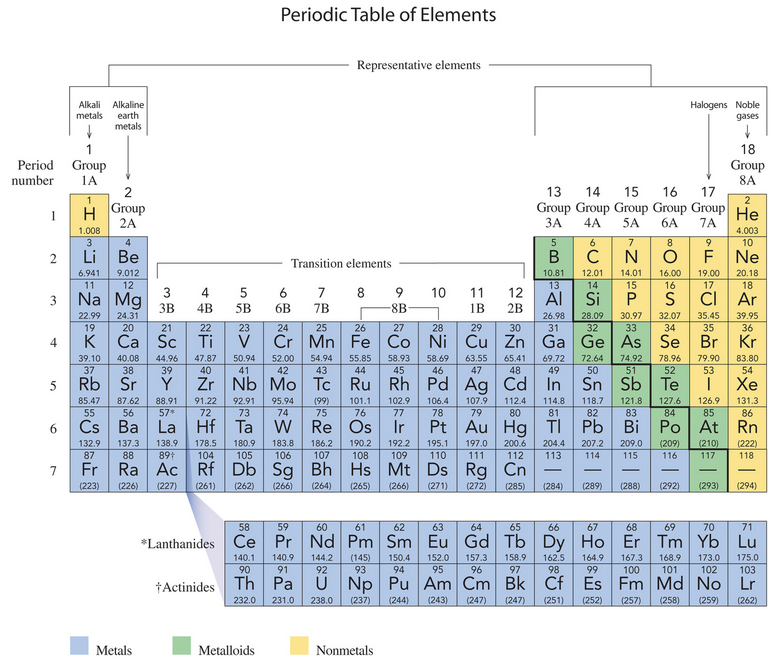
The organization of the periodic table directly correlates to the structure and the arrangement of the electrons within a given atom.
The blocks correlate to the type of orbital. For instance, the s block correlates to the s orbital whereas the p block correlates to the p orbitals.
Each element, in a given block, corresponds to one electron in that type of orbital. For instance, hydrogen is in the first column of the s block. Therefore, hydrogen has one electron in an s orbital. Helium, which is the next element after hydrogen, is in the second column of the s block. Therefore, helium adds one more electron to that orbital, resulting in a total of two electrons in the s block.
How many d electrons are found in cobalt?
- Five d electrons
- 10 d electrons
- Seven d electrons
- Two d electrons
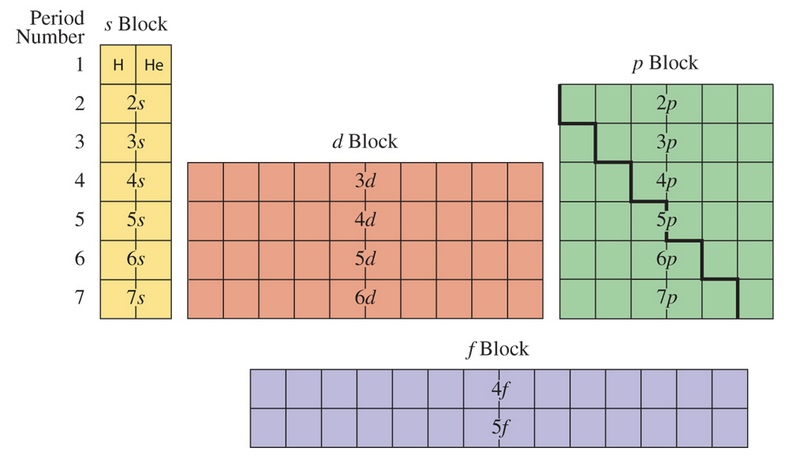
Seven d electrons
Ex.
Cobalt contains seven d electrons .
Remember that each element in a given block corresponds to one electron in that type of orbital. Because cobalt is found in the d block and is the seventh element in the first row of the d block, it will contain seven d electrons.
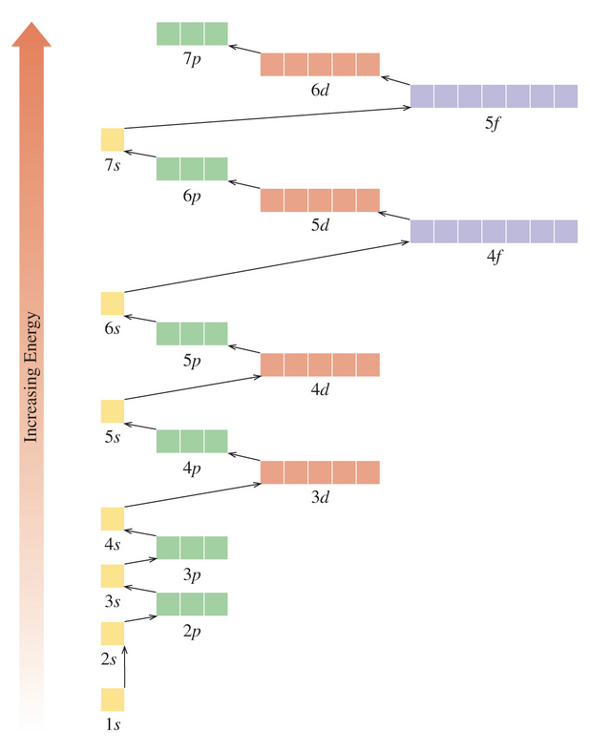
Electron configurations are a way to represent where the electrons are and how many electrons exist in a given element. In other words, electron configurations keep track of the placement of electrons within the energy levels and orbitals in a given atom, in order of increasing energy.
Select the correct electron configuration for Cu.
- 1s22s22p63s23p64s23d9
- 1s22s22p63s23p64s14d10
- 1s22s22p63s23p64s13d10
- 1s22s22p63s23p64s24d9
1 s 2 2 s 2 2 p 6 3 s 2 3 p 6 4 s 1 3 d 10
Ex.
The correct electron configuration for copper is 1s 22s 22p 63s 23p 64s 13d 10 .
Copper is in the first row of the transition elements. The predicted electron configuration is 1 s 2 2 s 2 2 p 6 3 s 2 3 p 6 4 s 2 3 d 9 which is one away from having filled d orbitals. As a result, one of the 4 s electrons is promoted to the 3 d orbital so the d orbitals are filled. The stability of having filled d orbitals is worth the investment of energy needed to promote the electron from the 4 s orbital to the 3 d orbital.
Remember that orbitals fill in order of increasing energy, beginning with 1 s , 2 s , 2 p , 3 s , and so on. In addition, the s orbitals hold a maximum of two electrons, whereas each p orbital holds two for a maximum of six electrons .

Electron configurations are a way to represent where the electrons are and how many electrons exist in a given element. In other words, electron configurations keep track of the placement of electrons within the energy levels and orbitals in a given atom, in order of increasing energy.
Select the correct electron configuration for F − .
- 1s22s22p6
- 1s22s22p53s1
- 1s22s22p4
- 1s22s23p5
1 s 2 2 s 2 2 p 6
Ex.
The electron configuration for F − is 1s 22s 22p 6 .
When determining the electron configuration of an ion, first write the configuration of the neutral atom. For F, it is 1 s 2 2 s 2 2 p 5 . One electron is gained to form the fluoride ion. When forming an anion, the electron is added to the next available orbital following the same pattern used for writing the electron configuration of the neutral atom. The additional electron is added to the 2 p orbital.
Remember that orbitals fill in order of increasing energy, beginning with 1 s , 2 s , 2 p , 3 s , and so on. In addition, the s orbitals hold a maximum of two electrons, whereas each p orbital holds two for a maximum of six electrons .

The periodic table contains a wealth of information based on how the elements are arranged. This information provides predictive power, in that chemists can extrapolate information about chemical and physical properties based on an element’s position on the periodic table. For instance, the elements comprising the noble gases are non-reactive or inert gases.
Which list of elements belongs to the family commonly called the noble gases?
- Helium, neon, and argon
- Oxygen, fluorine, and neon
- Hydrogen and helium
- Fluorine, chlorine, and bromine
Helium, neon, and argon
Ex.
Helium, neon, and argon are found in column 8A and belong to the family called the noble gases.
Elements in the same column are commonly known as a family or a group. Because helium, neon, and argon are in the same column, they are part of a family. The same can be said also of fluorine, chlorine, and bromine.
Several columns have special names based on the chemical and physical properties of those elements. For instance, fluorine, chlorine, and bromine are in column 7A and are called the halogens.
Elements that are in the same row are said to be in the same period. This applies to hydrogen and helium, as well as oxygen, fluorine, and neon.
An orbital is a region within the atom where the electrons are likely to be found. Each orbital has a specific shape.
For instance, the s orbital has a spherical shape, resulting in one type of s orbital. In each quantum level, there is one s orbital which is spherical and gets larger with increasing n.
The p orbitals have a dumbbell shape, resulting in three types of p orbitals. In each quantum level, there are three p orbitals.
What is the maximum number of electrons that can be found in an individual orbital?
- Eight
- One
- Six
- 10
- 14
- Two
Two
Ex.
Two electrons can be found in an individual orbital.
Each orbital can only hold a maximum of two electrons, no matter what the shape of the orbital is.
The periodic trend for electron affinity values is not as consistent as for other trends. Which statement best describes the trend?
- Electron affinity becomes more negative going from left to right but does not have a clear trend going from top to bottom for most columns.
- Electron affinity does not have a clear trend in either the rows or the columns.
- Electron affinity becomes more negative going from top to bottom but does not have a clear trend going from left to right.
- Electron affinity only has a trend in group 1A metals becoming more negative from top to bottom.
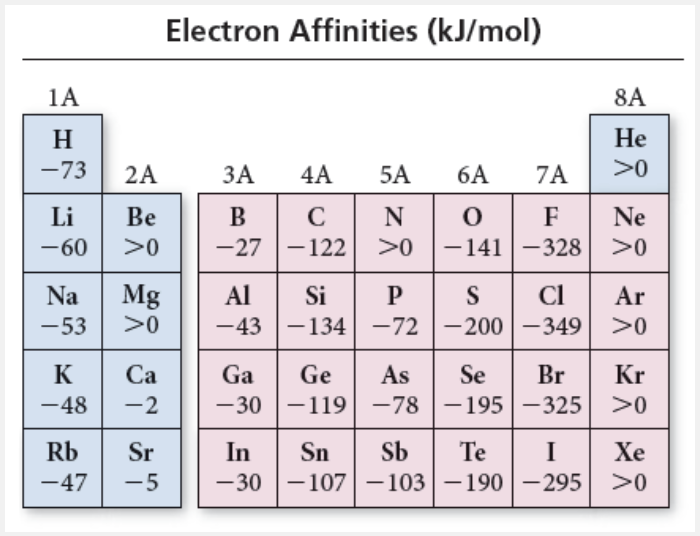
Electron affinity becomes more negative going from left to right but does not have a clear trend going from top to bottom for most columns.
Ex.
Electron affinity becomes more negative going from left to right but does not have a clear trend going from top to bottom for most columns.
The only trend seen in the columns is for the group 1A metals, which has more positive values moving from top to bottom of the column. The other groups do not show any consistent trend.
The presence of unpaired electrons in an atom determines whether or not an atom is attracted to a magnet or not. Are there unpaired electrons in phosphorus atom? If so, how many?
- Yes, 1
- No
- Yes, 2
- Yes, 3

Yes, 3
Ions result from the gain or loss of one or more electrons. The change in the number of electrons results in a change in size for the ion as compared to the neutral atom.
Anions are _____ than their neutral parent atom, and cations are _____ than their neutral parent atom.
- larger; larger
- smaller; larger
- larger; smaller
- smaller; smaller
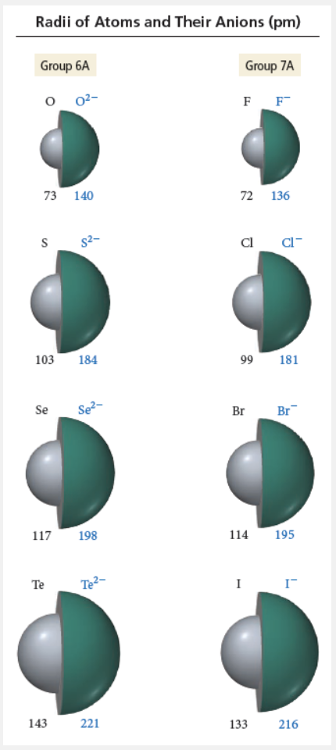
larger; smaller
Ex.
Anions are larger than their neutral parent atom because the nuclear charge remains the same but the number of electrons increases. Therefore, the attractive force between the nucleus and each electron is lower, which results in an increase in size.
Cations are smaller than their neutral parent atom because the nuclear charge remains the same but the number of electrons decreases. Therefore, the attractive force between the nucleus and each electron is higher, which results in a decrease in size.
...
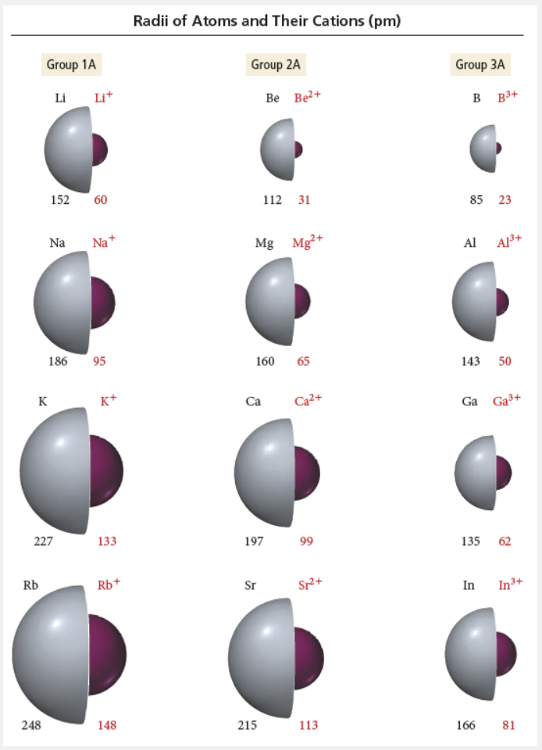
Electron configurations are a way to represent where the electrons are and how many electrons exist in a given element. In other words, electron configurations keep track of the placement of electrons within the energy levels and orbitals in a given atom, in order of increasing energy.
Select the correct electron configuration for Ti 2+ .
- 1s22s22p63s23p64s2
- 1s22s22p63s23p63d2
- 1s22s22p63s23p64s23d4
- 1s22s22p63s23p64s23d2
1 s 2 2 s 2 2 p 6 3 s 2 3 p 6 3 d 2
Ex.
The electron configuration for Ti 2+ is 1s 22s 22p 63s 23p 63d 2.
When determining the electron configuration of an ion, first write the configuration of the neutral atom. For Ti 2+ , it is 1 s 2 2 s 2 2 p 6 3 s 2 3 p 6 4 s 2 3 d 2 . Two electrons are lost to form the titanium ion. When forming a cation, electrons are removed from the energy level with the highest n value. Within the highest energy level, electrons are removed in order of p then s . For Ti 2+ , the two electrons are removed from the 4 s orbital.
Remember that orbitals fill in order of increasing energy, beginning with 1 s , 2 s , 2 p , 3 s , and so on. In addition, the s orbitals hold a maximum of two electrons, whereas each p orbital holds two for a maximum of six electrons .
Elements in the same column belong to the same family or group, as they have the same number of valence electrons. The valence electrons are the electrons in the outermost shell, and they are a major factor in determining the chemical and physical properties of an element. The number of valence electrons can be determined from the electron configuration as well as the group number.
How many valence electrons are present in sulfur?
- Four
- 16
- 32
- Six
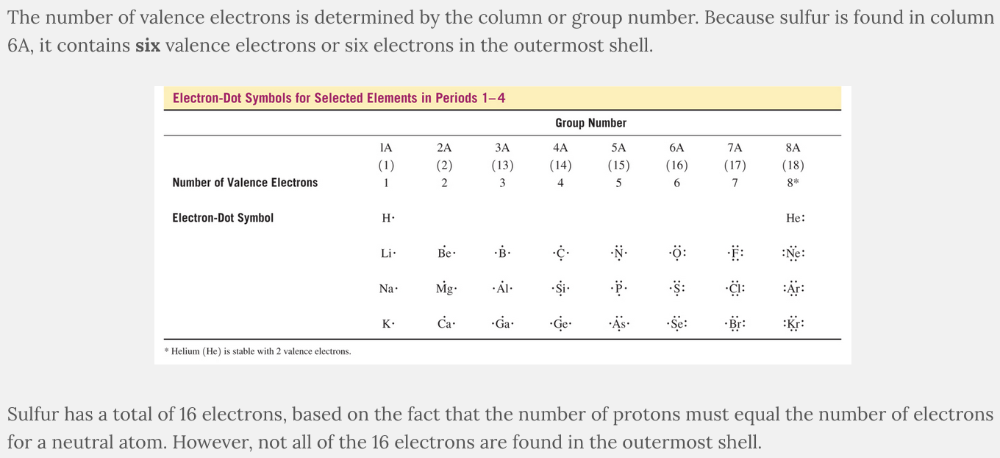
Six
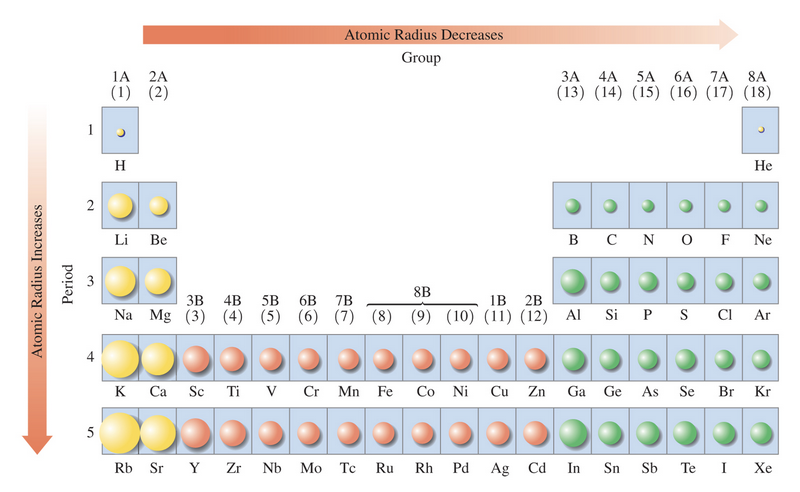
One of several trends found in the periodic table relates to the atomic radius or the size of an atom. The general trend in atomic radius is that moving down the periodic table, the size increases; moving across the periodic table from left to right, the size decreases. Therefore, rubidium has the largest atomic radius whereas helium has the smallest.
What factor causes the atomic radius to increase while moving down the periodic table, from top to bottom?
- The protons repel the electrons and push them farther away from the nucleus.
- The valence electrons jump into a higher energy level.
- The number of electron shells increases.
- The positively charged protons pull the electrons toward the nucleus.
The number of electron shells increases.
Ex.
While moving down the periodic table, from top to bottom, the number of electron shells increases and this causes the atomic radius to increase.
The atomic radius increases moving down the periodic table from the top to the bottom due to the addition of electrons in the next energy level. Each successive energy level is farther away from the nucleus, causing the radius to increase.
The atomic radius decreases moving across the periodic table from the left to the right due to an increasing number of protons. The positively charged protons in the nucleus pull the negatively charged electrons closer to the nucleus, causing the radius to decrease.
The effective nuclear charge is the amount of charge experienced by an electron taking into account any shielding effects from other electrons. Electrons between the nucleus and the electron of interest cause shielding and reduce the actual charge felt by the electron of interest.
Compare the outermost electron in each of the following atoms. Which one will experience the smallest effective nuclear charge?
- Calcium
- Potassium
- Germanium
- Selenium
Potassium
Ex.
Effective nuclear charge increases from left to right. Therefore, the outermost electron of potassium will experience the lowest effective nuclear charge.
One of several trends found in the periodic table relates to metallic character. Elements that have more metallic character tend to lose valence electrons easily.
Which element has the least metallic character?
- Fluorine, F
- Sodium, Na
- Cesium, Cs
- Silicon, Si
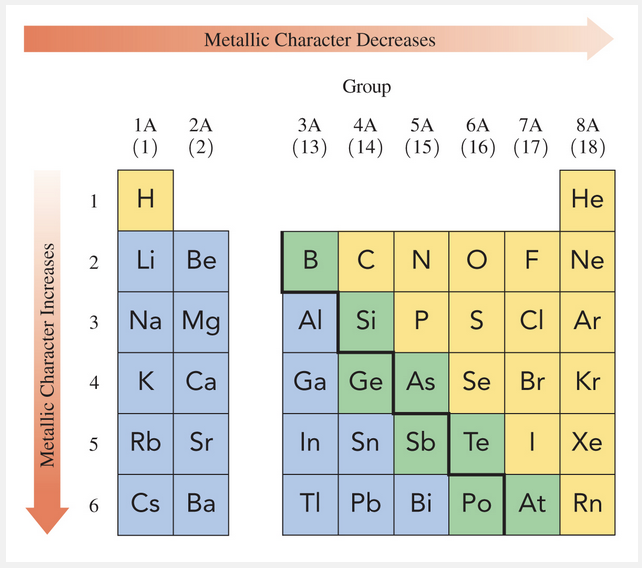
Fluorine, F
Ex.
Fluorine, F has the least metallic character.
Metallic character is the ability to lose valence electrons easily. Metals tend to lose valence electrons easily; therefore, they have more metallic character. Nonmetals tend to gain electrons because they have less metallic character. The metals are found on the left side of the periodic table (except for hydrogen), whereas the nonmetals are found on the right side of the periodic table.
Fluorine is a nonmetal and is found on the left side of the periodic table. Therefore, fluorine is the element with the least metallic character.
Additional energy is required to move second and successive electrons from an ion. Which element could have the following series of ionization energies (IE)?
IE 1 = 738 kJ/mol
IE 2 = 1450 kJ/mol
IE 3 = 7730 kJ/mol
IE 4 = 10545 kJ/mol
IE 5 = 13627 kJ/mol
IE 6 = 17995 kJ/mol
- Magnesium
- Chlorine
- Sodium
- Nitrogen
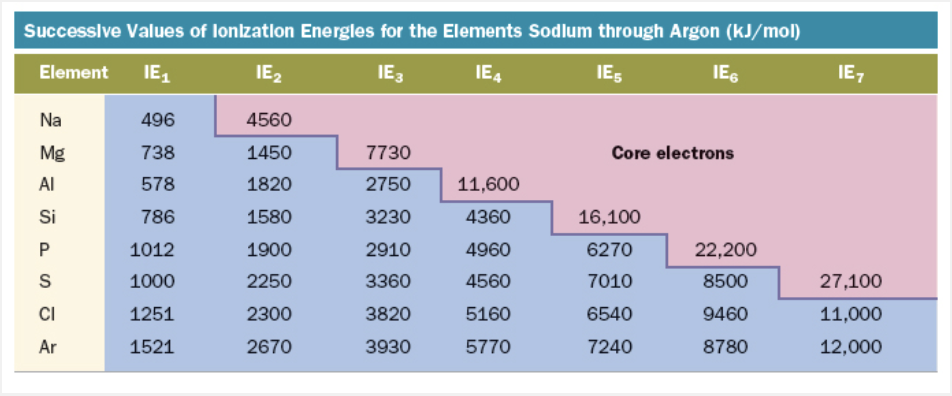
Magnesium
Ex.
The given ionization energies are for magnesium . A review of the given values finds that, while there is an increase between each successive ionization energy, the largest increase is between the second and third ionization energies.
IE 1 = 738 kJ/mol
IE 2 = 1450 kJ/mol
IE 3 = 7730 kJ/mol
IE 4 = 10545 kJ/mol
IE 5 = 13627 kJ/mol
IE 6 = 17995 kJ/mol
This indicates that removal of the third electron will be removing a core electron rather than a valence electron. The first two ionization energies, which are before the large increase, are for the removal of the valence electrons. Magnesium has two valence electrons and could have this set of ionization energies.
Sodium has one valence electron and will have a large increase after the first ionization energy. Chlorine has seven valence electrons and will have a large increase after the seventh ionization energy. Nitrogen has five valence electrons and will see a large increase after the fifth ionization energy.
Which element requires the most energy to lose one electron?
- Cesium, Cs
- Potassium, K
- Fluorine, F
- Helium, He
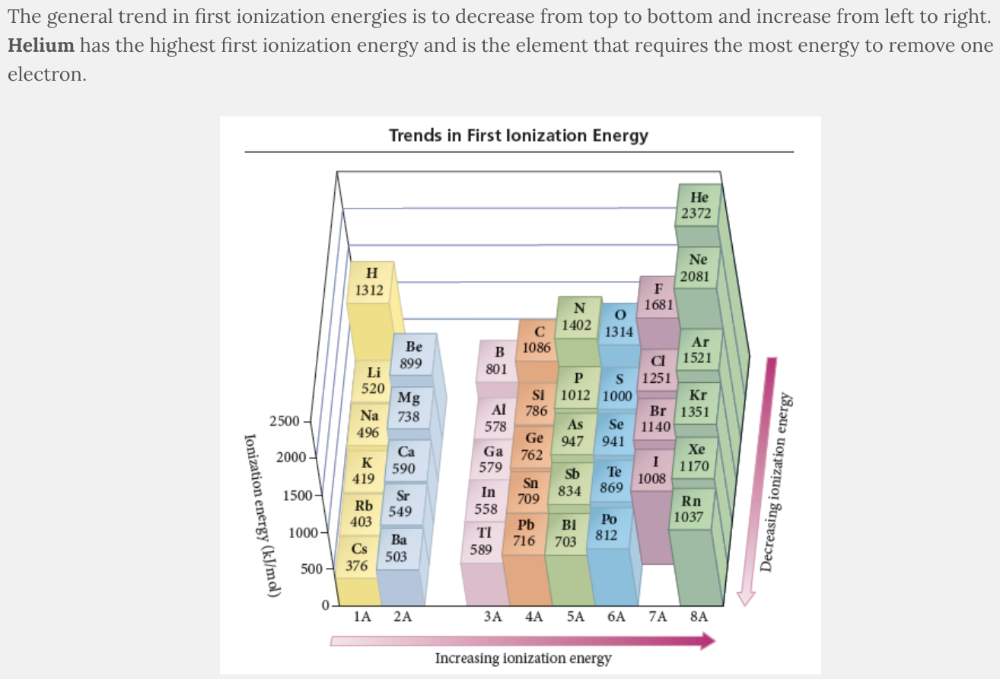
Helium, He
Which one of the following statements is true regarding ionization energies?
- Ionization energies for removing valence electrons are exothermic and endothermic for removing core electrons.
- Ionization energies are all endothermic.
- First ionization energies are exothermic, while second and successive ionization energies are exothermic.
- Ionization energies are all exothermic.
Ionization energies are all endothermic.